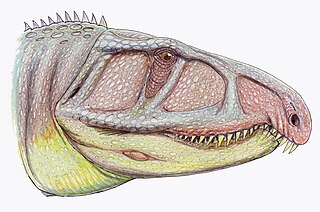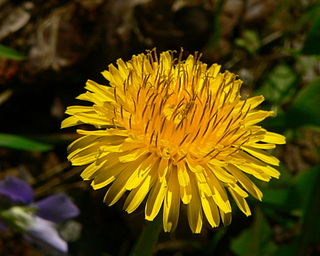
Mongolia is a landlocked country in East Asia, bordered by Russia to the north and China to the south. It covers an area of 1,564,116 square kilometres, with a population of 3.5 million, making it the world's most sparsely populated sovereign state. Mongolia is the world's largest landlocked country that does not border a closed sea, and much of its area is covered by grassy steppe, with mountains to the north and west and the Gobi Desert to the south. Ulaanbaatar, the capital and largest city, is home to roughly half of the country's population.

Hordeum is a genus of annual and perennial plants in the grass family. They are native throughout the temperate regions of Africa, Eurasia, and the Americas.

Garjainia is an extinct genus of erythrosuchid archosauriform reptile from the Olenekian of Russia and South Africa. It was approximately 1.5–2 metres (4.9–6.6 ft) long. It contained two species, Garjainia prima from the Yarengian/Yarkenskian Supergorizont of Russia, and Garjainia madiba from the Burgersdorp Formation of South Africa. "Vjuskovia triplicostata", a name assigned to some erythrosuchid fossils from Russia, has been synonymized with Garjainia prima.

Archosaurus is an extinct genus of carnivorous proterosuchid archosauriform reptile. Its fossils are dated to the latest Permian of Russia and Poland, it is one of the earliest known archosauriforms. The type and only species is Archosaurus rossicus, known from several fragmentary specimens which cumulatively represent parts of the skull and cervical vertebrae. It would have been 3 metres (9.8 ft) long when fully grown.
Dongusuchus is an extinct genus of archosaur. Fossils have been found from the Donguz Formation outcropping on the banks of the Donguz River in the Orenburg Oblast of Russia. They are associated with a fossil assemblage called the Eryosuchus Fauna, named after the capitosaurid Eryosuchus, the most common organism found from the assemblage. The locality dates back to the Anisian and early Ladinian stages of the Middle Triassic.
Energosuchus is an extinct genus of rauisuchian. Fossils are present from the upper Karyomayol and lower Synya Formations outcropping along the banks of the Bolshaya Synya river in the Timan-North Urals region in northern European Russia, as well as from the Bukobay Formation in the southern part of Bashkortostan in the southern Urals of European Russia. Both localities date back to the Ladinian stage of the Middle Triassic.
Jushatyria is an extinct genus of archosaur. Fossils have been found in the Koltaevo III Locality, district of Kumertau near the Ural Mountains in European Russia from the Bukobay Gorizont. The locality dates back to the Ladinian stage of the Middle Triassic. Additional material has been described from a locality on the banks of the Berdyanka River that was previously assigned to a rauisuchid-like archosaur. However, this material differed from the original specimens because it lacked slit-like antorbital openings accompanying the antorbital fossa. Nesbitt (2009) and Gower and Sennikov (2000) suggested that all material currently referred to Jushatyria most likely does not represent a single taxon. Thus, Jushatyria is known only from its holotype PIN 2867/5, an incomplete left maxilla. As the maxilla is damaged, many "rauisuchian" characters could not be verified. Jushatyria was reassigned as an indeterminate archosaur on the basis of the presence of an antorbital fossa on the lateral surface of the maxilla.
Tsylmosuchus is an extinct genus of proterosuchid archosauriform reptile known from Western Russia. Fossils referred to Tsylmosuchus occurred over a wide area in sediments corresponding to the Induan and Olenekian stages of the Early Triassic. Most of these fossils are fragmentary neck vertebrae which were originally reported as sharing similarities with crocodile-line archosaurs (pseudosuchians) such as Mandasuchus. As a result, Tsylmosuchus was first described as part of the family Rauisuchidae, making it supposedly one of the oldest known archosaurs. However, its fragmentary remains do not show any of the distinguishing features of rauisuchids or even pseudosuchians in general, so Tsylmosuchus has more recently been interpreted as an indeterminate archosauriform. Although three species of Tsylmosuchus have been named, they lack diagnostic traits and are probably not distinct from each other. In 2023, Tsylmosuchus was reinterpreted as a proterosuchid, specifically a member of the subfamily Chasmatosuchinae.
Dorosuchus is an extinct genus of archosauriform previously assigned to the family Euparkeriidae. It lived during the Anisian stage of the Middle Triassic. Fossil material is known from Sol-Iletsk in Orenburg Oblast, Russia. The type species is D. neoetus, named in 1989.
Vjushkovisaurus is an extinct genus of Middle Triassic archosauriform. It is known from the Anisian-aged Donguz Gorizont in Sol-Iletsk, Orenburg Oblast, Russia. The genus was named in 1982, with the type species being V. berdjanensis. Material has been collected in the Berdyanka II locality from a fossil assemblage called the Eryosuchus Fauna along the Berdyanka River, specifically in a sand-carbonate concretion in the upper part of the main river channel. Vjushkovisaurus is known only from the holotype PIN 2865/62, a partial postcranial skeleton which consists of 12 presacral vertebrae, left humerus, ribs, a fragment of the coracoid and a fragment of the fibula.
Vytshegdosuchus is an extinct genus of paracrocodylomorph archosaur known from the Early Triassic Yarenskian Gorizont of the Komi Republic of the European section of Russia. It contains a single species, Vytshegdosuchus zheshartensis. Vytshegdosuchus was named by Andreii Sennikov in 1988.

Youngosuchus is an extinct genus of archosaur from the Middle Triassic of China. The type species is Y. sinensis. Y. sinensis was first described in 1973 as a new species of the erythrosuchid Vjushkovia. In 1985, it was reassigned as its own genus of rauisuchid. A 1992 study supported the original classification of Youngosuchus sinensis as an erythrosuchid, but more recent studies classify it as a "rauisuchian"-grade loricatan archosaur completely unrelated to Vjushkovia, which is most likely a synonym of Garjainia.
Vonhuenia is an extinct genus of proterosuchid, a basal archosauriform from the Early Triassic of Russia. Fossils have been found in the Vokhminskaya Formation, along the Vetluga River that are Induan in age, making Vonhuenia one of the earliest archosauriforms.
Blomosuchus is an extinct genus of archosauriform from the Early Triassic of Russia. The type species was named in 1992 as Blomia georgii. However, the name Blomia was preoccupied by a genus of mites in the family Glycyphagidae (Blomia), so the genus was renamed Blomosuchus in 1997. Fossils of Blomosuchus have been found along the Vetluga River besides fossils of another problematic archosauriform, Vonhuenia.
Exilisuchus is an extinct genus of archosauromorph reptile from the Early Triassic of Russia. The type species E. tubercularis was named in 1979. Fossils are known from two Russian assemblages, the Benthosuchus - Thoosuchus assemblage and the Angusaurus assemblage. Both are Olenekian in age. Although initially believed to be a proterosuchid archosauriform, a 2016 analysis found that it also shared features with tanystropheids, and thus is currently classified as Archosauromorpha incertae sedis. Due to the small amount of preserved material, this genus is sometimes considered a nomen dubium.

Wangisuchus is an extinct genus of archosauriform reptile from the Middle Triassic of China that is known from fragmentary fossil jaw bones. These bones were found at the Hsishihwa locality in the upper Ermaying Formation, which dates to the late Anisian stage about 242 million years ago. Wangisuchus was named in 1964 by Chinese paleontologist Yang Zhongjian, who described a single species, Wangisuchus tzeyii, on the basis of these bones.

Uralosaurus is an extinct genus of erythrosuchid archosauriform known from the Middle Triassic Donguz Formation of southeastern European Russia. It contains a single species, Uralosaurus magnus. It was named by Vitalii Georgievich Ochev in 1980 as a species of Erythrosuchus otherwise known from the Triassic of Africa and reassigned to its own genus by Andrey G. Sennikov in 1995.

Askellia is a genus of Asian and North American plants in the tribe Cichorieae within the family Asteraceae.

Askellia pygmaea, the dwarf alpine hawksbeard, is a species of Asian and North American plants in the tribe Cichorieae within the family Asteraceae.

Crepidinae is a subtribe of Cichorieae in the family Asteraceae.








